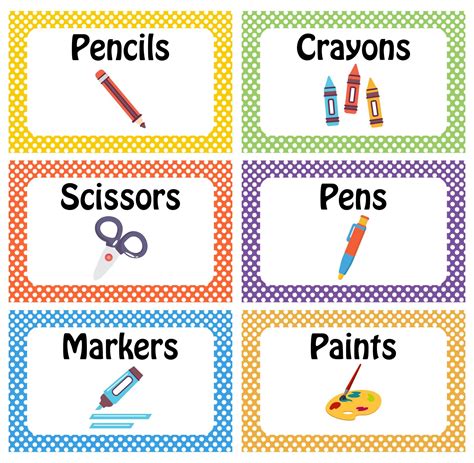Organization and efficiency are crucial in the classroom, and labels can be a lifesaver. They help students identify and locate items quickly, saving valuable time and minimizing distractions. This comprehensive guide will provide you with everything you need to know about labels for your classroom.

Why Labels Matter
According to the National Association of Elementary School Principals (NAESP), students who are organized and have access to clear labels spend less time searching for materials and more time engaged in learning activities. Labels also contribute to:
- Improved classroom management: Clear labels keep the classroom organized and free from clutter.
- Increased student independence: Labels empower students to locate and retrieve items independently, fostering self-reliance.
- Enhanced student engagement: Organized and labeled classrooms create a positive learning environment that promotes student involvement.
- Reduced teacher workload: Well-labeled materials save teachers time searching for items and allow them to focus on teaching.
Types of Labels
There are numerous types of labels available for classroom use. Choose the ones that best suit your needs and the items you wish to label. Some common options include:
- Self-adhesive: These labels are easy to apply and reposition.
- Printable: These labels can be customized and printed to your specifications.
- Magnetic: These labels are perfect for whiteboards, file cabinets, and metal surfaces.
- Removable: These labels can be removed without leaving a residue.
Labeling Best Practices
To ensure that your labels are effective and long-lasting, follow these best practices:
- Use clear and concise language: Students should be able to easily understand what the label represents.
- Use high-contrast colors: Labels with contrasting colors, such as black and white or blue and yellow, are easier to read.
- Use large font sizes: Font size should be large enough for students to read from a distance.
- Laminate labels for durability: Laminating labels will protect them from wear and tear.
- Consider using symbols: Symbols can be used to represent specific items or concepts, making them especially useful for younger students.
Creative Ideas for Labels
Don’t limit yourself to traditional labels. There are numerous creative ways to use labels in your classroom. Here are a few ideas:
- Use stickers as labels: Stickers are a fun and engaging way to label items.
- Create QR code labels: QR codes can be scanned to provide students with additional information or resources related to the labeled item.
- Design labels with your students: Involve students in the labeling process to encourage ownership and creativity.
- Use labels to create visual displays: Labels can be used to create colorful and informative displays on classroom walls or bulletin boards.
Common Mistakes to Avoid
Avoid these common mistakes when labeling your classroom:
- Using too small or hard-to-read labels: Labels should be large enough and clear enough for students to read easily.
- Using labels that are difficult to remove: Choose labels that can be removed easily without leaving a residue.
- Overlabeling: Avoid labeling too many items, as this can create visual clutter and confusion.
- Using labels without clear purpose: Each label should have a specific purpose and represent an item or concept that is relevant to the curriculum.
Table 1: Types of Labels and Their Uses
| Label Type | Uses |
|---|---|
| Self-adhesive | General-purpose labeling, suitable for most surfaces |
| Printable | Custom labels, ideal for specific items or projects |
| Magnetic | Labels for metal surfaces, such as whiteboards or file cabinets |
| Removable | Temporary labeling, easy to remove without damage |
Table 2: Benefits of Using Labels in the Classroom
| Benefit | Description |
|---|---|
| Improved organization | Clear labels keep the classroom organized and free from clutter |
| Increased student independence | Labels empower students to locate and retrieve items independently |
| Enhanced student engagement | Organized and labeled classrooms create a positive learning environment that promotes student involvement |
| Reduced teacher workload | Well-labeled materials save teachers time searching for items and allow them to focus on teaching |
Table 3: Creative Ideas for Using Labels in the Classroom
| Idea | Description |
|---|---|
| Sticker labels | Stickers are a fun and engaging way to label items |
| QR code labels | QR codes can be scanned to provide students with additional information or resources related to the labeled item |
| Student-designed labels | Involve students in the labeling process to encourage ownership and creativity |
| Visual display labels | Labels can be used to create colorful and informative displays on classroom walls or bulletin boards |
Table 4: Common Mistakes to Avoid When Labeling the Classroom
| Mistake | Consequences |
|---|---|
| Using too small or hard-to-read labels | Students may have difficulty identifying or reading the labels |
| Using labels that are difficult to remove | Labels may damage surfaces or leave a residue |
| Overlabeling | Excess labeling can create visual clutter and confusion |
| Using labels without clear purpose | Labels should have a specific purpose and represent an item or concept that is relevant to the curriculum |
